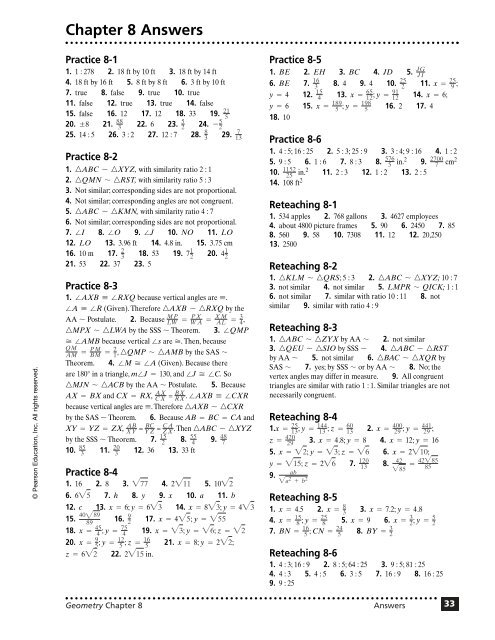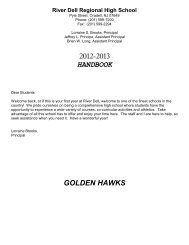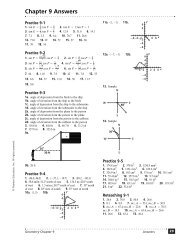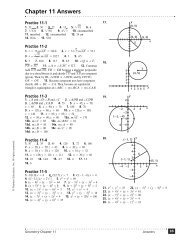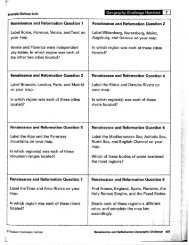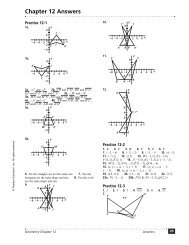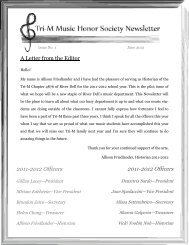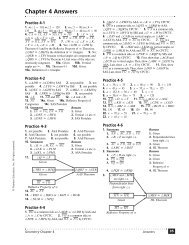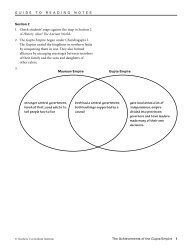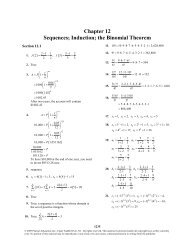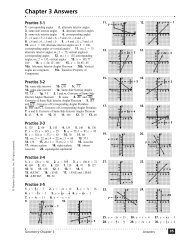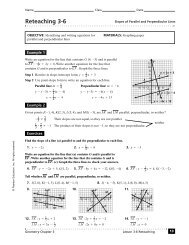Chapter 8 Answers (continued)
Chapter 8 Answers (continued)
Chapter 8 Answers (continued)
Create successful ePaper yourself
Turn your PDF publications into a flip-book with our unique Google optimized e-Paper software.
<strong>Chapter</strong> 8 <strong>Answers</strong><br />
© Pearson Education, Inc. All rights reserved.<br />
Practice 8-1<br />
1. 1 : 278 2. 18 ft by 10 ft 3. 18 ft by 14 ft<br />
4. 18 ft by 16 ft 5. 8 ft by 8 ft 6. 3 ft by 10 ft<br />
7. true 8. false 9. true 10. true<br />
11. false 12. true 13. true 14. false<br />
21<br />
15. false 16. 12 17. 12 18. 33 19. 5<br />
88<br />
5<br />
5<br />
20. 48 21. 3<br />
22. 6 23.<br />
2<br />
24. -2<br />
8 7<br />
25. 14 : 5 26. 3 : 2 27. 12 : 7 28.<br />
3<br />
29. 13<br />
Practice 8-2<br />
1. ABC XYZ, with similarity ratio 2 : 1<br />
2. QMN RST, with similarity ratio 5 : 3<br />
3. Not similar; corresponding sides are not proportional.<br />
4. Not similar; corresponding angles are not congruent.<br />
5. ABC KMN, with similarity ratio 4 : 7<br />
6. Not similar; corresponding sides are not proportional.<br />
7. I 8. O 9. J 10. NO 11. LO<br />
12. LO 13. 3.96 ft 14. 4.8 in. 15. 3.75 cm<br />
2 1 1<br />
16. 10 m 17. 3<br />
18. 53 19. 7 2<br />
20. 4 2<br />
21. 53 22. 37 23. 5<br />
Practice 8-3<br />
1. AXB RXQ because vertical angles are .<br />
A R (Given). Therefore AXB RXQ by the<br />
MP PX XM 3<br />
AA Postulate. 2. Because LW = WA = AL = 4 ,<br />
MPX LWA by the SSS Theorem. 3. QMP<br />
AMB because vertical s are .Then, because<br />
QM PM 2<br />
AM = BM = 1, QMP AMB by the SAS <br />
Theorem. 4. M A (Given). Because there<br />
are 180° in a triangle, mJ = 130, and J C. So<br />
MJN ACB by the AA Postulate. 5. Because<br />
AX BX<br />
AX = BX and CX = RX, CX = RX. AXB CXR<br />
because vertical angles are .Therefore AXB CXR<br />
by the SAS Theorem. 6. Because AB = BC = CA and<br />
AB BC CA<br />
XY = YZ = ZX, XY = YZ = ZX. Then ABC XYZ<br />
15 55 48<br />
by the SSS Theorem. 7. 2<br />
8. 4<br />
9. 7<br />
85 20<br />
10. 3<br />
11. 3<br />
12. 36 13. 33 ft<br />
Practice 8-4<br />
1. 16 2. 8 3. "77 4. 2"11<br />
5. 10"2<br />
6. 6"5<br />
7. h 8. y 9. x 10. a 11. b<br />
12. c 13. x = 6; y = 6"3<br />
14. x = 8 "3;y = 4"3<br />
40#89 9<br />
15. 16. 17. x = 4 "5;y = "55<br />
89<br />
2<br />
45 75<br />
18. x = 4 ; y = 4<br />
19. x = "3; y = "6; z = "2<br />
9 12 16<br />
20. x = 5; y = 5 ; z = 5<br />
21. x = 8; y = 2 "2;<br />
z = 6"2<br />
22. 2"15<br />
in.<br />
Practice 8-5<br />
JG<br />
1. BE 2. EH 3. BC 4. JD 5. JI<br />
16<br />
25<br />
25<br />
6. BE 7. 3<br />
8. 4 9. 4 10. 2<br />
11. x = 9 ;<br />
15<br />
65 91<br />
y = 4 12. 4<br />
13. x = 12; y = 12<br />
14. x = 6;<br />
189 198<br />
y = 6 15. x = 5 ; y = 5<br />
16. 2 17. 4<br />
18. 10<br />
Practice 8-6<br />
1. 4 : 5; 16 : 25 2. 5 : 3; 25 : 9 3. 3 : 4;9 :16 4. 1 : 2<br />
576<br />
5. 9 : 5 6. 1 : 6 7. 8 : 3 8. in. 2 2700<br />
9. cm 2<br />
10. in. 2 5<br />
7<br />
1152<br />
25<br />
11. 2 : 3 12. 1 : 2 13. 2 : 5<br />
14. 108 ft 2<br />
Reteaching 8-1<br />
1. 534 apples 2. 768 gallons 3. 4627 employees<br />
4. about 4800 picture frames 5. 90 6. 2450 7. 85<br />
8. 560 9. 58 10. 7308 11. 12 12. 20,250<br />
13. 2500<br />
Reteaching 8-2<br />
1. KLM QRS;5 :3 2. ABC XYZ; 10 : 7<br />
3. not similar 4. not similar 5. LMPR QICK; 1 : 1<br />
6. not similar 7. similar with ratio 10 : 11 8. not<br />
similar 9. similar with ratio 4 : 9<br />
Reteaching 8-3<br />
1. ABC ZYX by AA 2. not similar<br />
3. QEU SIO by SSS 4. ABC RST<br />
by AA 5. not similar 6. BAC XQR by<br />
SAS 7. yes; by SSS or by AA 8. No; the<br />
vertex angles may differ in measure. 9. All congruent<br />
triangles are similar with ratio 1 : 1. Similar triangles are not<br />
necessarily congruent.<br />
Reteaching 8-4<br />
25 144 60<br />
400 441<br />
1.x = 13; y = 13 ; z = 13<br />
2. x = 29 ; y = 29 ;<br />
420<br />
z = 29<br />
3. x = 4.8; y = 8 4. x = 12; y = 16<br />
5. x = "2; y = "3; z = "6 6. x = 2 "10;<br />
120 42 42"85<br />
y = "15; z = 2"6<br />
7.<br />
13<br />
8. =<br />
"85 85<br />
ab<br />
9.<br />
"a 2 1 b 2<br />
Reteaching 8-5<br />
8<br />
1. x = 4.5 2. x = 3<br />
3. x = 7.2; y = 4.8<br />
15 25<br />
3 5<br />
4. x = 8 ; y = 8<br />
5. x = 9 6. x = 2 ; y = 2<br />
16 24<br />
3<br />
7. BN = 5 ; CN = 5<br />
8. BY = 2<br />
Reteaching 8-6<br />
1. 4 : 3; 16 : 9 2. 8 : 5; 64 : 25 3. 9 : 5; 81 : 25<br />
4. 4 : 3 5. 4 : 5 6. 3 : 5 7. 16 : 9 8. 16 : 25<br />
9. 9 : 25<br />
Geometry <strong>Chapter</strong> 8 <strong>Answers</strong> 33
<strong>Chapter</strong> 8 <strong>Answers</strong> (<strong>continued</strong>)<br />
Enrichment 8-1<br />
1. 10 lb 2. $250; costs have not changed during the<br />
past year. 3. $240,000 4. $168,750 5. $6785<br />
6. $106 7. 360 yd 8. 40 9. 42 10. 63<br />
Activity 2: Analyzing<br />
Stage 1: 12; 4<br />
1 1<br />
Stage 2: 9 ; 5 3<br />
1 1<br />
Stage 3: 192; 27; 79<br />
Enrichment 8-2<br />
1.–4. Check students’ work.<br />
Enrichment 8-3<br />
1. Statements Reasons<br />
1. ABCD is a trapezoid 1. Given<br />
2. AD 6 BC<br />
2. Def. of a trapezoid<br />
3. AED CEB 3. Vertical angles are .<br />
4. EBC EDA 4. Alt. int. angles are .<br />
5. AED CEB 5. AA Similarity Post.<br />
2. Statements Reasons<br />
1. T, U, and V are mdpts 1. Given<br />
"5<br />
3<br />
2<br />
2. TU 6 RV, UV 6 TR, 2. Triangle Midsegment<br />
and TV 6 US<br />
Theorem<br />
3. TUVR and TUSV are 3. Def. of parallelogram<br />
parallelograms.<br />
4. TUV R 4. Opposite s of a<br />
parallelogram are .<br />
5. UTV S 5. Opposite s of a<br />
parallelogram are .<br />
6. QRS VUT 6. AA Similarity Post.<br />
3. Using the distance formula, AB = "180 or 6 "5,<br />
BC = "45 or 3 "5, CA = 15, ST = 10, TB = "80 or<br />
4 "5,andBS = "20 or 2 . If the two triangles are<br />
CA 15 3 AB 6"5 3 BC 3"5<br />
ST = 10 = 2 = TB = = = = =<br />
4"5<br />
2 BS 2"5<br />
.<br />
similar, then corresponding sides are proportional. Therefore,<br />
CA AB BC<br />
Because ST = TB = BS , ABC TBS by the<br />
SSS Similarity Postulate.<br />
Enrichment 8-4<br />
1. The triangles have two congruent angles; AA Similarity<br />
AB 1 BD AB<br />
(DE 2 BC)AB<br />
Postulate. 2. DE = BC<br />
3. BD = BC<br />
4. 800 yd 5. 4500 ft 6. 43 ft 7. 9 m<br />
Enrichment 8-5<br />
1. 18 2. 1 3. 19 4. 3 5. 8 6. 7 7. 22<br />
8. 9 9. 13 10. 4 11. 5 12. 6 13. 12<br />
14. 17 15. 2 16. 10 17. 21 18. 15 19. 20<br />
20. 16 ARCHIMEDES OF SYRACUSE<br />
Enrichment 8-6<br />
1. 1 : 4 2. 2 : 1 3. 4 : 3 4. 1 : 16<br />
<strong>Chapter</strong> Project<br />
Activity 1: Doing<br />
Check students’ work.<br />
Activity 3: Doing<br />
Check students’ work.<br />
Activity 4: Thinking<br />
The entire snowflake at each stage will be inside the regular<br />
hexagon. The area of the hexagon is 2 square units, so the area<br />
of the snowflake is always less than 2 square units.<br />
Activity 5: Modeling<br />
Check students’ work.<br />
✔ Checkpoint Quiz 1<br />
6<br />
1.<br />
12<br />
2. 1 : 48 3. 11 4. 6 5. O 6. MO<br />
8 3<br />
7. 3.6 ft 8. no; 20 2 7 9. 780 mi<br />
✔ Checkpoint Quiz 2<br />
1. yes; AA similarity postulate 2. yes; SAS similarity<br />
postulate 3. 5 4. 13.7 5. x = 4.5, y = 7.5<br />
1<br />
6. 8 3<br />
7. 2.5<br />
<strong>Chapter</strong> 8 Test, Form A<br />
24<br />
2<br />
1. 28 2.<br />
19<br />
3. 45 4.<br />
3<br />
5. ABC XYZ<br />
by the AA Postulate 6. not similar 7. KPM <br />
RPQ by the SAS Theorem 8. 30 ft 9. 9<br />
3<br />
10. 6"5<br />
11. B 12. 12 13. 2<br />
14. 6<br />
18<br />
15. 7 16. Check students’ work. 17. If two parallel<br />
lines are cut by a transversal, alternate interior angles are congruent.<br />
Therefore, ABC EDC by the AA Postulate.<br />
18. 64 : 9 19. 9 : 1 20. x = 9; y = 6 "3;z = 3"3<br />
10 8<br />
60<br />
21. x = 3 ; y = 3<br />
22. C 23.<br />
13<br />
<strong>Chapter</strong> 8 Test, Form B<br />
9 3<br />
1. 6 2. 12 3. 2<br />
4.<br />
2<br />
5. ABC EDC<br />
by the AA Postulate 6. not similar 7. ABC <br />
RST by the SAS Theorem 8. 24 ft 9. 12<br />
21 45<br />
10. 5"2<br />
11. C 12. 4 13. 4<br />
14.<br />
11<br />
15. 20 16. Check students’ work. 17. Sample: Each<br />
of the two smaller triangles contains a right angle because<br />
the altitude is perpendicular to AC. Also, each of the smaller<br />
triangles shares an angle with ABC. Therefore, each of the<br />
smaller triangles is similar to ABC by the AA Postulate<br />
and, by transitivity, they are similar to each other.<br />
20 15<br />
18. 9 : 4 19. 9 : 1 20. x = 7 ; y = 7 21. x = 30;<br />
y = 8 "15;z = 2"15<br />
22. D 23. 168<br />
25<br />
© Pearson Education, Inc. All rights reserved.<br />
34<br />
<strong>Answers</strong> Geometry <strong>Chapter</strong> 8
<strong>Chapter</strong> 8 <strong>Answers</strong> (<strong>continued</strong>)<br />
© Pearson Education, Inc. All rights reserved.<br />
Alternative Assessment, Form C<br />
TASK 1: Scoring Guide<br />
AA Similarity Postulate and SAS and SSS Similarity<br />
Theorems; check students’ work.<br />
3 Student gives correct answers and accurate drawings<br />
and explanations.<br />
2 Student gives mostly correct answers, drawings, and<br />
explanations.<br />
1 Student gives answers, drawings, and explanations that<br />
contain significant errors.<br />
0 Student makes little or no effort.<br />
TASK 2: Scoring Guide<br />
Claim 1 is true, and Claim 2 is false. Claim 3 is partly true; the<br />
triangles are similar, but the ratio of the areas is 1 : 4, not 1 : 2.<br />
3 Student gives correct answers and provides logical reasons<br />
to support the answers.<br />
2 Student gives mostly correct answers, but the work may<br />
contain minor errors or omissions.<br />
1 Student gives answers that contain significant errors.<br />
0 Student makes little or no effort.<br />
TASK 3: Scoring Guide<br />
One method is to pick any<br />
point A on land and measure<br />
AB and AC. Then select a<br />
1<br />
fraction (say, 2), and mark<br />
X and Y halfway from A<br />
to B and C, respectively.<br />
Then measure XY. Then<br />
BC = 2 ? XY.<br />
3 Student gives a mathematically<br />
correct procedure and explanation.<br />
A<br />
2 Student gives a procedure and<br />
explanation that may contain minor errors.<br />
1 Student gives an invalid procedure or a valid procedure<br />
with little or no explanation.<br />
0 Student makes little or no effort.<br />
B<br />
X<br />
?<br />
Y<br />
C<br />
TASK 4: Scoring Guide<br />
Comparing the adult to the baby, we have:<br />
• ratio of heights 3.5 : 1<br />
• ratio of weights 27.6 : 1<br />
• ratio of head circumference 1.7 : 1<br />
Because the ratio of heights is not close to the ratio of head<br />
circumference, the baby and the adult are not similar. (The<br />
baby’s head will grow more slowly than the rest of the body.)<br />
Interestingly, the ratio of weights doesn’t suggest similarity<br />
either. If the two were similar, the ratio of the volume (and,<br />
therefore, of the weight) would be about 3.5 3 to 1, or about<br />
43 : 1. But it is about 27.6 : 1, suggesting that the adult is<br />
leaner than the baby. In summary, babies tend to be chubbier<br />
and have larger heads (proportionally) than adults.<br />
3 Student gives a mathematically sound analysis.<br />
2 Student gives an explanation that contains minor errors<br />
or omissions.<br />
1 Student gives an explanation containing significant errors<br />
or omissions.<br />
0 Student makes little or no effort.<br />
Cumulative Review<br />
1. D 2. B 3. A 4. B 5. C 6. C<br />
7. D 8. A 9. B 10. D 11. B 12. C<br />
13. D 14. D 15. A 16. 120 m 2 17. 10<br />
18. Congruent triangles have congruent corresponding<br />
angles and congruent corresponding sides, so they have a<br />
similarity ratio of 1 : 1. Similar triangles have congruent<br />
corresponding angles but do not necessarily have congruent<br />
corresponding sides.<br />
19. Sample:<br />
20. If cows do not have six legs, then pigs cannot fly.<br />
Geometry <strong>Chapter</strong> 8 <strong>Answers</strong> 35


